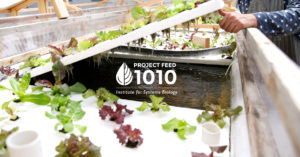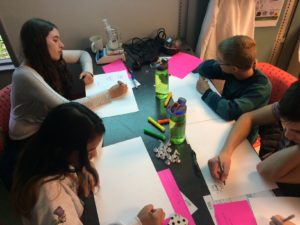- Introduction to Systems
- Systems Are Everywhere
- Bioengineering a Sustainable World
-
Computational Modeling
- Demystifying Machine Learning
- Ecological Networks
- Environmental Influence on Gene Networks
-
Invisible Forest
Unit Plan Lesson 0.5 – It’s Only a Drop of Water (Project Based Learning Plan) Lesson 1 – A Breath of Oxygen Lesson 2 – Who’s who in the photosynthetic world from macro to microscale Lesson 3 – Tools of the Trade Exploratorium: Collecting Oceanographic Data From Where We Cannot See Lesson 3.5 Phytoplankton, Spectrophotometry & Microscopy Labs Lesson 4 – Scaling up: Linking cells in a drop of seawater to global patterns Lesson 5 – Dive into Data: Raw to Results Contributors
-
Modeling Sustainable Food Systems
Food Security Module Overview Lesson FS1: Introduction to Food Security Lesson FS2: Critically Evaluating Food Production Techniques Application: Designing, constructing, and reengineering a system Lesson FS3: Who Cares? Stakeholders! Lesson FS4: Food Security as a System Lesson FS5: Why Don’t We Just Grow More? Lesson FS6: Where Does Our Food Come From? Lesson FS7: Summative Assessment – United Nations Council Meeting Contributors
-
Observing Beyond Our Senses
Unit Plan Lesson 1 – Introduction to Saline Environments & Microbial Halophiles Lesson 2 – Design Process-Measuring Wind Speed Lesson 3 – Inferences From Proxy Variable Mock AFM Lesson 4 – Signal and Noise Lesson 5 – Inferring Properties and Calibrations Lesson 6 – Death Valley Middle Basin Case Study Contributors
-
Ocean Acidification
Unit Plan Lesson 1 – Critical and Systems Evaluation of News Articles Lesson 2 – Exploring CO2 to Better Understand Ocean Acidification Lesson 3 – Defining the Problem: Ocean Acidification Lesson 4 – Planning Cohesive Experiments Lesson 5a – Ocean Acidification Experimentation Lesson 5b – Online Data and Supplemental Evidence Lesson 5b – Online Data and Supplemental Evidence (pre-2018 version) Lesson 5c – Using Ocean Acidification Models to Make Predictions Lesson 6 – Global Ocean Acidification Summit Contributors
-
Carbon’s Fate
-
Systems Medicine Education
-
Standards Addressed
- Community-Contributed
Food Security Unit Overview and Background
 Globally, one in nine people in the world today (795 million) are undernourished. The vast majority of the world’s hungry people live in developing countries, where 12.9% of the population is undernourished. Humankind is headed toward a catastrophic situation resulting from water shortage (at least 30% gap between demand and supply by 2030), and rapid shrinkage of per capita arable land. The ratio of urban to rural population has reversed dramatically since the 1950s. Population growth – expected to reach 10 billion by 2050 – is outpacing agricultural innovation, creating a demand that the industry will not be able to satisfy. It’s necessary to make more efficient use of cultivated and non-cultivated land, because continuing to deplete natural resources is not sustainable. Put in simple terms, food insecurity is a complex issue with complex consequences. Understanding complexity and finding solutions to this real-world issue requires systems thinking – both in research and in education.
Globally, one in nine people in the world today (795 million) are undernourished. The vast majority of the world’s hungry people live in developing countries, where 12.9% of the population is undernourished. Humankind is headed toward a catastrophic situation resulting from water shortage (at least 30% gap between demand and supply by 2030), and rapid shrinkage of per capita arable land. The ratio of urban to rural population has reversed dramatically since the 1950s. Population growth – expected to reach 10 billion by 2050 – is outpacing agricultural innovation, creating a demand that the industry will not be able to satisfy. It’s necessary to make more efficient use of cultivated and non-cultivated land, because continuing to deplete natural resources is not sustainable. Put in simple terms, food insecurity is a complex issue with complex consequences. Understanding complexity and finding solutions to this real-world issue requires systems thinking – both in research and in education.
We are addressing both the science, through our research, and the mitigation, through developing curriculum. It is our goal to bring this high level, hands-on learning to students. In this curriculum module, students in high school life and physical science courses act as interdisciplinary scientists and delegates to investigate how food insecurity can be eradicated in countries around the world.
Students research various countries with high prevalence of food insecurity and, using their knowledge from various lessons, model solutions through designing, building (optional), scaling up, and analyzing data from sustainable food systems. They then prepare for a mock UN summit to propose solutions to their assigned country's food insecurity crisis.
Food Security Curriculum Module Summary
Students take an interdisciplinary approach to understand a global issue. The driving question: “How can we think and act on a systems level to produce and consume food resources that will be environmentally sustainable and sufficient for global needs?” Students learn that systems thinking is helpful in identifying influences and interactions within the food security system. After critically examining the environmental tradeoffs involved with various food production techniques, students engineer a system, such as an aquaponic system, to evaluate the potential of scaling up aquaponics to fill the future food gap. Next, students examine the origins of food and resources required to produce it. Throughout this module, student groups investigate various aspects of the food crisis in a specific country, which culminates in a UN council meeting to propose a solution.
- Overview Flowchart: Use this Food Security Module Flow Chart to help direct the flow of this module
- Complete Food Security (FS) Module (updated 02/23/2021) via PDF. This also serves as a unit plan, lists all NGSS, etc.
- Project Feed 1010 website: projectfeed1010.com.
- Project Feed 1010 data management site: https://github.com/baliga-lab/pf1010-web/. Please note the old data management hub (pf1010.systemsbiology.net) is no longer available. If you would like access to this, please use the github link or email us at see@isbscience.org.
- A number of helpful videos can be viewed on our YouTube channel: https://www.youtube.com/channel/UCbMLa5LinsdPjivEtIDgJNA
- Examples of teacher Donor's Choose projects that have been fully funded to build aquaponic systems
- Jennifer Barreto - Florida: Funded
- Tami Caraballo - Washington: Funded
- Tami Caraballo - Washington - Year 2: Funded
- Jennifer Barreto - Florida - Year 2: Funded
- Lesson Plans: The actual teacher lesson plans are located on the lesson pages that can be accessed from the main Food Security module page as well as through the links below.
- Standards Addressed: This module aligns with the Next Generation Science Standards. Please see disciplinary core ideas, science and engineering practices (SEP), and crosscutting concepts (CCC) addressed in this module in the buttons on the upper-left of this page, arranged in three-dimensional bundles. The bundled NGSS are also listed in the master PDF. Please also see the individual lesson plan pages for additional information on what students learn and do. For more information on the standards our modules address, please also see our Standards Addressed page.
- If you need any more information and/or have questions, please feel free to contact us.
- Lesson FS1: Introduction to Food Security - Food security is a foreign concept to many Americans. Most believe that chronic hunger and malnutrition happens only to people in developing nations or to the homeless. In reality, 1 in 6 people in America go hungry every day and are not food secure. Throughout the lesson, students will develop and refine their understanding of food security and they are able to compare different countries and analyze what food security issues they have based on the three pillars using global statistics.
- Lesson FS2: Critically Evaluating Food Production Techniques - A variety of agricultural production systems are used to produce food around the world. Some systems rely on the continuous addition of resources, while others use resources more efficiently. In this lesson, students evaluate various food production techniques in terms of their environmental sustainability and potential for producing enough food to feed a growing world population.
- Application 1: Designing, Constructing and Re-engineering a System - Using mathematics and computational analysis, students design aquaponic systems to be part of the solution to food insecurity in a developing country. In this NGSS STEM activity and optional lab, students can either use real data collected from an aquaponic system at Institute for Systems Biology (ISB) or data from their own aquaponic system to calculate water efficiency and the effects of scaling up a system.
- Lesson FS3: Who Cares? Stakeholders! - Stakeholders are a vital part of the food security system. It is important for students to realize that to solve the global issue of food insecurity, all of the stakeholders’ voices must be represented. In a system, there are often trade-offs to being able to make something work. They will have an impact on the system and other stakeholders, based on the choices they make and the resources they use.
- Lesson FS4: Food Security as a System - The goal of this lesson is to encourage students to look at the topic of food security using a systems approach, and to evaluate the stability of our global food production by assessing the interactions within the system. Students will review the definition of a system and discuss how approaching a problem or issue by modeling it as a system can lead to both improved understanding and more effective problem-solving.
- Lesson FS5 - Why Don't We Just Grow More? - Students will continue to explore the idea that when nodes are interacting in a system, modifying one node can have far reaching consequences for the entire system. In this lesson, students will focus on the stakeholders introduced in Lesson FS3, by analyzing an article and evaluating the impact that possible solutions to global food insecurity will have on stakeholders.
- Lesson FS6 - Where Does Our Food Come From? - How does our food get from farm to table and what resources are required to get it there? In this activity, students will play a game to produce pizza. While the game uses economics as a driving force to model food production, students must use a systems thinking approach to strategize and make decisions.
- Lesson FS7: United Nations Food and Agriculture Organization Summit - Students conduct a United Nations Food and Agriculture Organization Summit (UN Summit) in order to address the food security challenges of the countries they’ve researched throughout the Food Security module. Through the UN Summit, students recommend actions to improve the food production system as a representative of their country and follow-up with an individual critical evaluation of the proposed actions.
More Information
Many people helped during the development and dissemination of this curriculum module. Please see this credit sheet for a list of people who have contributed to this work.
 FUNDING: This module has been possible through the National Science Foundation (DBI-1262637, MCB-1330912, MCB-1518261, DBI-1565166, MCB-1616955) and through crowdsourced funding via CrowdRise.
FUNDING: This module has been possible through the National Science Foundation (DBI-1262637, MCB-1330912, MCB-1518261, DBI-1565166, MCB-1616955) and through crowdsourced funding via CrowdRise.
License:
![]() Except where otherwise noted, the Modeling Sustainable Food Systems module, copyright Institute for Systems Biology (ISB) through Baliga Systems Education Experiences, is available under a Creative Commons Attribution-NonCommercial 4.0 International License. All logos, trademarks, and videos are property of their respective owners. This resource may contain links to websites operated by third parties. These links are provided for your convenience only and do not constitute or imply any endorsement or monitoring by ISB or ISB's funding agencies. Please confirm the license status of any third-party resources and understand their terms of use before reusing them.
Except where otherwise noted, the Modeling Sustainable Food Systems module, copyright Institute for Systems Biology (ISB) through Baliga Systems Education Experiences, is available under a Creative Commons Attribution-NonCommercial 4.0 International License. All logos, trademarks, and videos are property of their respective owners. This resource may contain links to websites operated by third parties. These links are provided for your convenience only and do not constitute or imply any endorsement or monitoring by ISB or ISB's funding agencies. Please confirm the license status of any third-party resources and understand their terms of use before reusing them.

